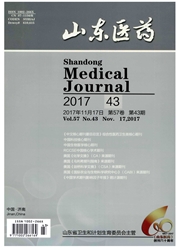

 中文摘要:
中文摘要:
目的:观察D-柠檬烯对酒精性脑损伤大鼠脑组织NF-κB、IκB及TNF-α表达的影响。方法60只Wist-ar大鼠随机分为6组,每组各10只。药物1、2、3组与模型组制作酒精性脑损伤模型,每日予50%乙醇灌胃,前2周为8 mL/(kg· d),后4周为12 mL/(kg· d),其中药物1、2、3组造模同时分别予100、200、400 mg/(kg· d)的D-柠檬烯灌胃;单纯药物组与空白对照组不制作动物模型,其中空白对照组每日予蒸馏水灌胃,单纯药物组在此基础上加400 mg/( kg· d) D-柠檬烯灌胃。实验第6周末处死动物,留取脑组织,HE染色,镜下观察其形态结构变化;免疫组化法测定脑组织中的NF-κB、IκB蛋白;ELISA双抗夹心法检测脑匀浆中的TNF-α。结果模型组神经元数量减少,分布不规则,细胞核明显固缩变形,药物1、2、3组脑组织形态结构变化逐渐减轻。模型组NF-κB阳性细胞数、IκB阳性细胞数与空白对照组相比,P均<0.05。药物1、2、3组NF-κB阳性细胞数减少、IκB阳性细胞数增多,与模型组相比,P均<0.05;药物3组与药物1、2组相比,P均<0.05。模型组大鼠脑匀浆中TNF-α表达高于空白对照组(P均<0.05);药物1、2、3组大鼠脑匀浆中TNF-α表达低于模型组(P均<0.05),且药物3组低于药物1、2组(P均<0.05)。结论 D-柠檬烯可降低酒精性脑损伤大鼠脑组织中NF-κB、TNF-α的表达,上调IκB的表达,进而减轻酒精性脑损伤。
 英文摘要:
英文摘要:
Objective To observe the effect of D-limonene on the NF-κB/IκB expression and serum TNF-αconcen-tration in rats with alcohol-induced brain injury.Methods Sixty Wistar rats were divided into six groups, with ten rats in each group.The rat models of alcoholic brain damage were made in the drug groups 1, 2, 3 and model group, which were administered with 50%ethanol by gavage, daily, 8 mL/(kg·d) in the first two weeks, 12 mL/(kg· d) in the following four weeks.At the same time, the rats in the drug groups 1, 2 and 3 were respectively treated with 100, 200 and 400 mg/(kg·d) D-lemonene by gavage.We did not make the animal model in the simple drug group and blank control group, but rats in the blank control group were treated with distilled water, and rats in the simple drug group were treated with 400 mg/( kg· d) D-limonene based on distilled water by gavage.After six weeks, the animals were all executed and the histol-ogy of brain was examined by HE staining and light microscope.The expression of NF-κB and I-κB in the brain tissues were tested by immunohistochemical method.In addition, the activity of TNF-αin brain was examined by a double antibody sandwich ELISA.Results The number of neurons in the model group was decreased, which showed irregular distribu-tion, nuclear obviously contracted and deformed, and the morphology of brain tissues in the drug groups 1, 2 and 3 gradu-ally reduced.Significant differences in the NF-κB positive cells and I-κB positive cells were found between the model group and the blank control group (all P〈0.05).The NF-κB positive cells were decreased and the NF-κB positive cells were in-creased in the drug groups 1, 2 and 3 as compared with that of the model group (all P〈0.05);and significant differences were found between group 3 and the drug groups 1 and 2 (all P〈0.05).TNF-αexpression in rat brain homogenate of the model group was higher than that of the blank control group (P〈0.05);the expression of TNF-αin rat brain homog
 同期刊论文项目
同期刊论文项目
 同项目期刊论文
同项目期刊论文
 期刊信息
期刊信息
